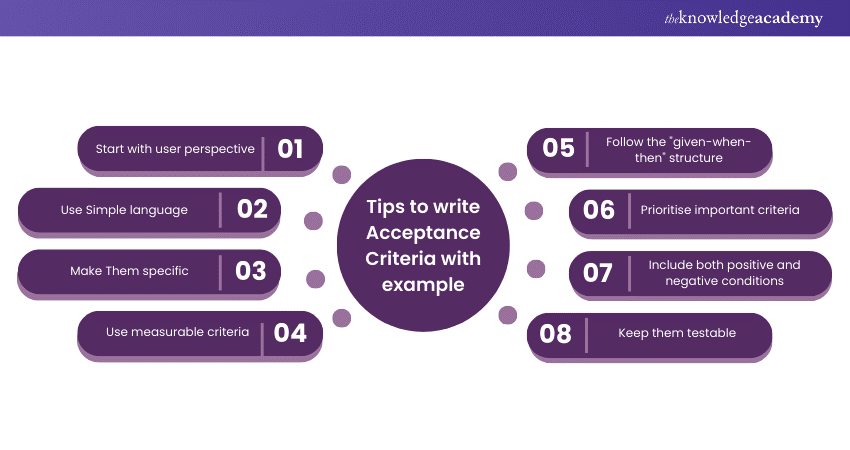We may not have the course you’re looking for. If you enquire or give us a call on 44 1344 203 999 and speak to our training experts, we may still be able to help with your training requirements.
Training Outcomes Within Your Budget!
We ensure quality, budget-alignment, and timely delivery by our expert instructors.

Agile is not just a methodology; it's a mindset that promotes flexibility, collaboration, and customer-centricity in project management. Within the Agile framework, Acceptance Criteria emerge as a crucial component, helping teams ensure that their work aligns with customer expectations and project goals. In this blog, we will discuss What are Acceptance Criteria, their significance, and how to craft effective ones.
Additionally, we will discuss the roles and responsibilities associated with them, their connection to user stories, and practical applications in Agile project management. So read this blog to explore What are Acceptance Criteria in Agile methodologies and learn how clear and well-defined criteria ensure the successful delivery of projects.
Table of contents
1) What are Acceptance Criteria in Agile?
2) The connection between Acceptance Criteria and user stories
3) Tips to write Acceptance Criteria
4) Responsibility for Acceptance Criteria
5) Tools and templates for managing Acceptance Criteria
6) Conclusion
What are Acceptance Criteria in Agile?
Acceptance Criteria in Agile are a set of well-defined, specific conditions or requirements that a product or feature must meet to be considered complete and satisfy the needs of the customer or stakeholders. They serve as a crucial component of user stories, which are short, simple descriptions of a feature or piece of functionality from an end user's perspective.
Acceptance Criteria act as the bridge between the product owner, who represents the customer's needs, and the development team, responsible for implementing those needs. They provide clear and unambiguous guidelines for both parties to understand when a particular user story is considered "done" and meets the expected quality standards.
The connection between Acceptance Criteria and user stories
User stories and Acceptance Criteria in Agile are closely intertwined, working together to ensure clear communication, effective development, and customer satisfaction. Let's delve into the relationship between these two essential Agile components:
1) User stories set the stage: User stories are short, simple descriptions of functionality or features from the end user's perspective. They serve as a way to express what a customer wants and why they want it. User stories typically follow the format: "As a [user type], I want [an action] so that [benefit/value]."
2) Acceptance Criteria define the details: While user stories provide a high-level view of what needs to be done, Acceptance Criteria add the critical specifics. They outline the conditions and requirements that must be met for the user story to be considered complete. Acceptance Criteria answer the question, "How will we know when this is done?" and are written in a clear, unambiguous, and testable manner.
3) Together, they clarify expectations: User stories and their associated Acceptance Criteria work together to eliminate misunderstandings and ambiguities. They provide a shared understanding of what the customer wants and what the development team needs to deliver. When both are well-defined, the likelihood of misinterpretation is minimised.
4) Testing and validation: Acceptance Criteria play a crucial role in testing and validation. Testers can use them as a basis for creating test cases and verifying that the user story has been implemented correctly. If all Acceptance Criteria are met, it's a strong indication that the user story is complete.
5) Iterative improvement: The relationship between user stories and Acceptance Criteria is iterative. As the team gains more insights or customer feedback, they can refine and update both user stories and Acceptance Criteria to ensure that the product continues to meet evolving needs.
Unlock the key to Agile Success with our Agile User Stories Course – Sign up now!
Tips to write Acceptance Criteria with example
Writing clear and effective Acceptance Criteria is essential for successful Agile project management. Here are some tips to help you write Acceptance Criteria:

1) Start with user perspective: Begin by considering the user's point of view. What will they expect from the feature or functionality? This helps you frame the Acceptance Criteria in terms of user needs.
2) Use simple language: Keep the language in your Acceptance Criteria straightforward and jargon-free. Make sure that anyone, even those not intimately familiar with the project, can understand them.
3) Make them specific: Acceptance Criteria should be detailed and specific. Avoid vague or generic statements. Ensure that there is no room for interpretation.
4) Use measurable criteria: Make the Acceptance Criteria measurable, meaning that you can objectively determine whether they have been met or not.
5) Follow the "given-when-then" structure: Organise your Acceptance Criteria using the "Given-When-Then" format. This helps clarify the context, action, and expected outcome for each criterion.
6) Prioritise important criteria: List your Acceptance Criteria in order of importance. Ensure that the most critical requirements are at the top of the list.
7) Include both positive and negative conditions: Define what constitutes success (positive conditions) and what should not happen (negative conditions) to provide a comprehensive view.
8) Keep them testable: Ensure that the Acceptance Criteria are testable. They should guide the testing process and make it easy to determine if the feature works as expected.
Embark on your Agile journey – Register for our Agile Overview Course today!
Responsibility for Acceptance Criteria
In Agile project management, clear and well-defined Acceptance Criteria are crucial for delivering a successful product that meets customer expectations. Various team members share responsibility for creating and managing Acceptance Criteria:
Product Owners
1) Primary responsibility: Product owners are typically the main stakeholders responsible for defining Acceptance Criteria.
2) What they do: They work closely with customers and stakeholders to understand their needs, translate those needs into user stories, and then develop and maintain the associated Acceptance Criteria. They also prioritise user stories based on business value.
3) Why it matters: Product owners ensure that the product aligns with customer expectations and business objectives. They play a critical role in defining what "done" means for each user story.
Scrum Masters:
1) Primary responsibility: Scrum masters facilitate Agile processes and collaboration, including the use of Acceptance Criteria.
2) What they do: Scrum masters assist product owners in refining user stories and Acceptance Criteria, help development teams understand the criteria, and ensure that criteria are integrated into the development process.
3) Why it matters: Scrum masters help maintain focus on Agile principles and practices, making sure Acceptance Criteria are effectively used and understood.
Development teams
1) Primary responsibility: Development teams are responsible for implementing the user stories and meeting the Acceptance Criteria.
2) What they do: Developers use Acceptance Criteria to guide their work, ensuring that the functionality they build aligns with customer needs and project goals. They also collaborate with product owners to clarify and refine criteria.
3) Why it matters: Development teams play a central role in turning Acceptance Criteria into a working product, and they ensure that each user story meets the specified criteria.
Quality Assurance/Testers
1) Primary responsibility: QA/testers use Acceptance Criteria as a basis for creating test cases and validating that the user story has been correctly implemented.
2) What they do: Testers verify that the product meets the Acceptance Criteria and report any deviations to the development team. They ensure that the product works as intended.
3) Why it matters: QA/testers help maintain product quality and ensure that it meets the defined criteria for completeness and functionality.
Be the catalyst for Agile transformation – Join our Agile Change Agent Course now!
Tools and templates for managing Acceptance Criteria
Effectively managing Acceptance Criteria in Agile projects is crucial for ensuring clear communication and successful product delivery. Here are some tools and templates that can assist in managing Acceptance Criteria:
1) Agile project management software: Popular tools like Jira, Trello, and Asana allow you to create user stories and Acceptance Criteria within the system. These tools enable collaboration, tracking, and easy reference during the project.
2) Spreadsheet software (e.g., Excel or Google Sheets): Create a simple spreadsheet to list and manage Acceptance Criteria. You can organise them by user story, prioritise them, and even include testing status.
3) Document templates: Word processing software like Microsoft Word or Google Docs can be used to create detailed documents that contain Acceptance Criteria. Templates can be customised to match the project's needs.
4) Agile management tools (e.g., Confluence): Tools like Confluence, which integrates with Jira, provide a collaborative environment to document and manage Acceptance Criteria, making it easy for cross-functional teams to work together.
5) Custom agile tools: Some teams develop or use custom tools or templates tailored to their specific project and Acceptance Criteria management needs.
6) Acceptance test-driven development (ATDD) Tools: ATDD tools like Cucumber and SpecFlow help automate the creation and validation of Acceptance Criteria. They allow you to write criteria in a natural language format and convert them into automated tests.
7) User story mapping tools: Tools like Miro or StoriesOnBoard help visualise user stories and their associated Acceptance Criteria, making it easier to understand their relationships and dependencies.
8) Collaboration tools (e.g., Slack, Microsoft Teams): These tools facilitate real-time communication and collaboration among team members. You can use channels or chat threads to discuss and clarify Acceptance Criteria.
9) Version control systems (e.g., Git): For more technical teams, version control systems can be used to manage and track changes to Acceptance Criteria documents, ensuring version history is maintained.
10) Agile whiteboards: Physical or digital whiteboards, like MURAL or Microsoft Whiteboard, can be used to visualise user stories and Acceptance Criteria during collaborative discussions and refinement sessions.
Don't miss out on the key Agile interview questions that can set you apart. Explore them now!
Conclusion
So this is all about What is Acceptance Criteria. Acceptance Criteria in Agile are the linchpin for ensuring that projects meet customer expectations, align with business objectives, and maintain a high level of transparency throughout development.
Unlock the power of Agile Programme Management (AgilePgM®) - Get started today!
Frequently Asked Questions
Upcoming Project Management Resources Batches & Dates
Date
 Certified Professional in Agile Project Management (CPAPM)
Certified Professional in Agile Project Management (CPAPM)
Thu 14th Nov 2024
Thu 16th Jan 2025
Thu 6th Mar 2025
Thu 22nd May 2025
Thu 24th Jul 2025
Thu 18th Sep 2025
Thu 20th Nov 2025
Thu 11th Dec 2025







 Top Rated Course
Top Rated Course



 If you wish to make any changes to your course, please
If you wish to make any changes to your course, please


